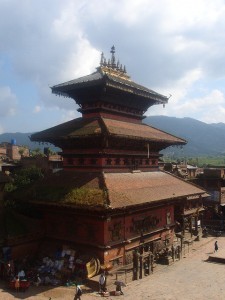 A living museum. That’s how the guide books describe Bhaktapur, Nepal’s “cultural gem”.
A living museum. That’s how the guide books describe Bhaktapur, Nepal’s “cultural gem”.
Such accolades seem two a penny these days and hearing a place described this way can make you sceptical, because all too often the praise turns out to be unfounded, the compliments little more than marketing exaggeration, deception at worst, wishful thinking at best.
So it’s refreshing to arrive in Bhaktapur and discover a place that is no exaggeration, it truly is a “gem”.
Founded in the 12th century by King Ananda Malla, Bhaktapur was the capital city of the Greater Malla Kingdonm until the 15th century and its architectural masterpieces are a magnificent testament to the craftsmanship and artistic traditions of the native Newars.
Elaborately carved doors and intricate windows adorn most buildings. Huge elaborate temples with pinnacles rise up above the town.Palatial baths, divine statues, spacious courtyards – it’s hard to know where to look and what to take in, because it’s all so mesmerising, all so beautiful.
It’s this beauty which no doubt ensured that Bhaktapur became listed as a UNESCO World Heritage Site.
For me the most delightful piece of craftsmanship was the 15th century “Peacock Window”, a delicately carved lattice window, with a peacock at its centre. But this is a really a rather arbirtary choice, because it’s impossible really to single out one work of art for praise.
Perhaps what struck me most about Bhaktapur though was the fact that the place still lives. By this I mean that it is still a vibrant living working town. It hasn’t become simply some outdoor museum.
In the pottery squares, the artisans still make their clay pots as they have done for centuries. Handmade paper is still lovingly crafted and turned into “paubha” scroll paintings, a collection of which are housed in the old Malla Palace of 55 Windows, now the National gallery.
Sure the stores cater for the tourist market – you can buy all the usual tourist bric-a-brac here – the wooden figurines, the handmade paper calendars, the t-shirts -but beside all that the town still has a hustle and bustle about it that makes it lively and stimulating, that makes the place real, and not just some preserved museum piece.
Something which struck me all to clearly as I sat in the mid-day sun on Durbar Square.
Suddenly I was aware of a high, painful wailing sound, coming slowly towards me. For a few moments it wasn’t clear what was happening, then from out of one of the dusty streets, a colourful procession of women came walking.
Slowly, slowly, holding one another up for support, raising their tear stained faces to the heavens.
They were mourning. Walking through the public square proclaiming the death of some loved one, openly manifesting their grief to God and the world. An intimate moment, occuring in this most public of places, as the tourists wandered by taking in the sights.
Death amid the temples and the t-shirts. So it goes, so it goes…